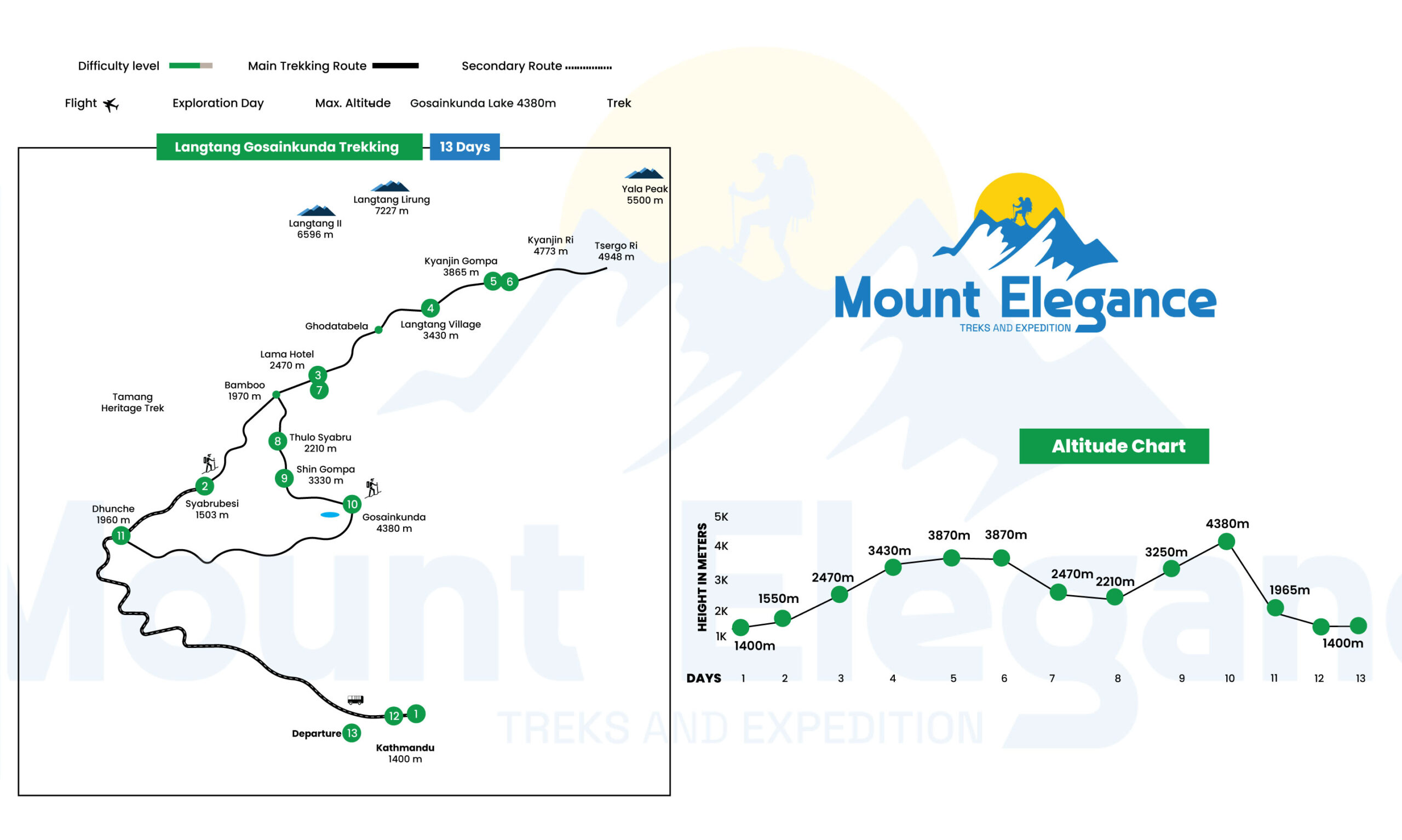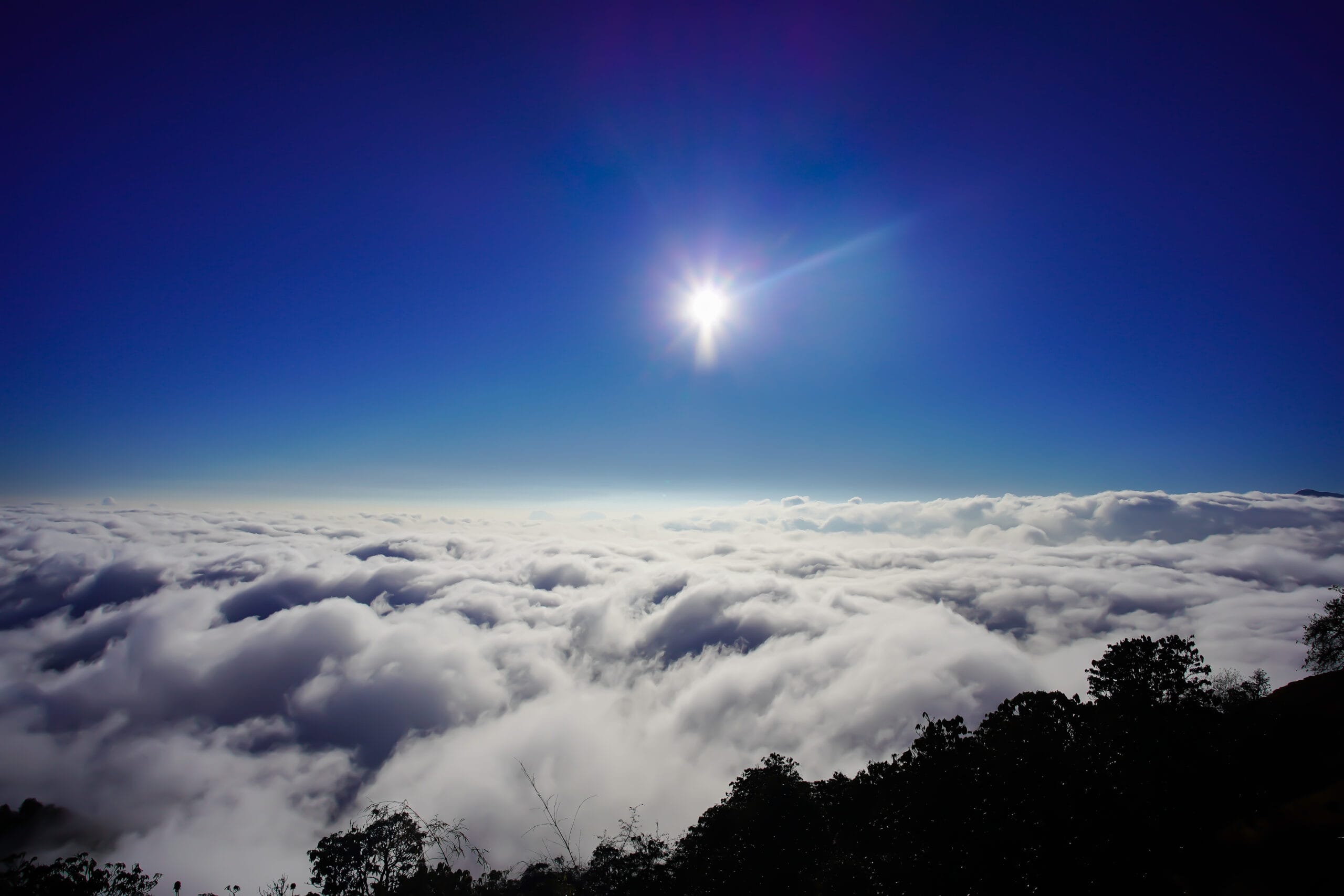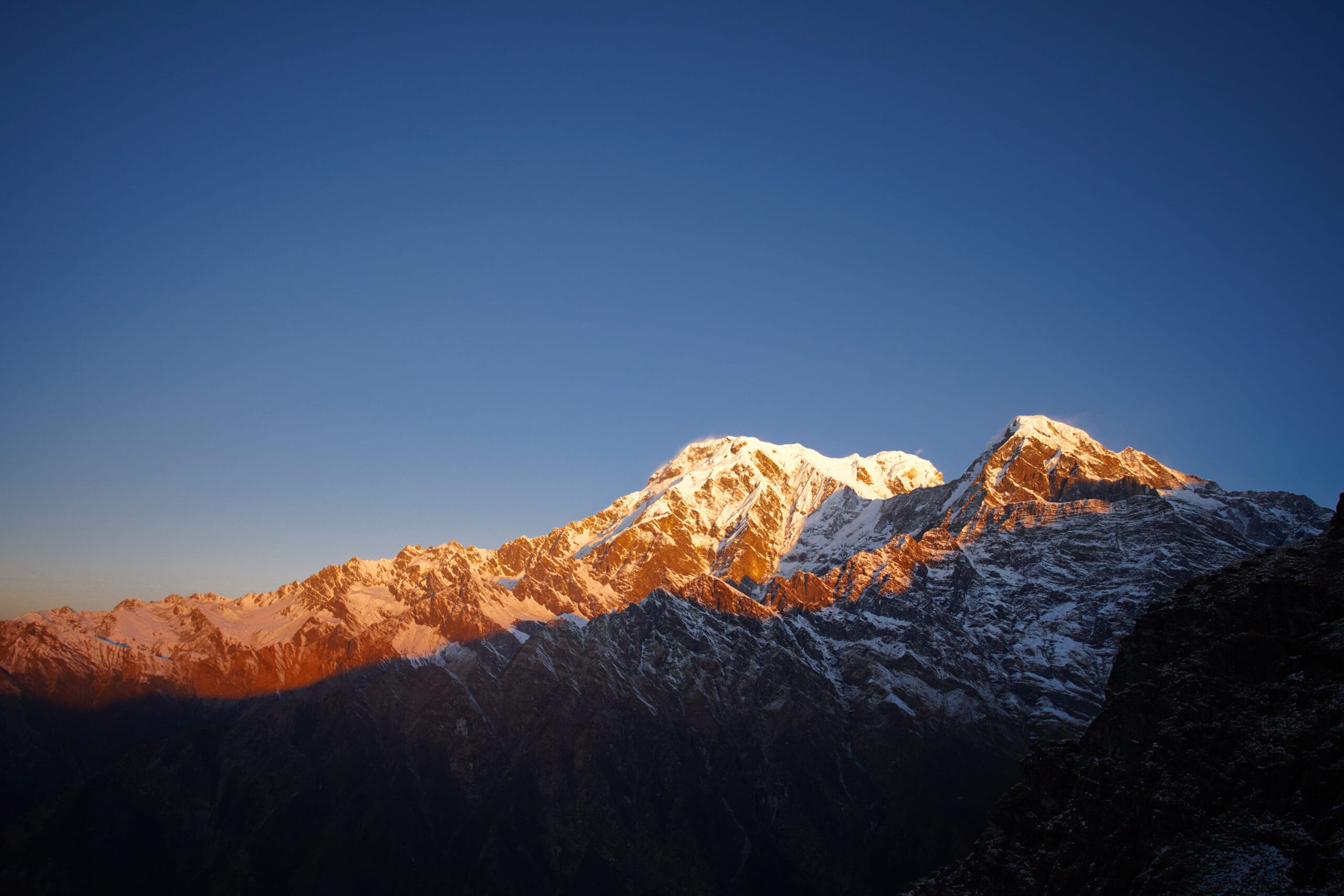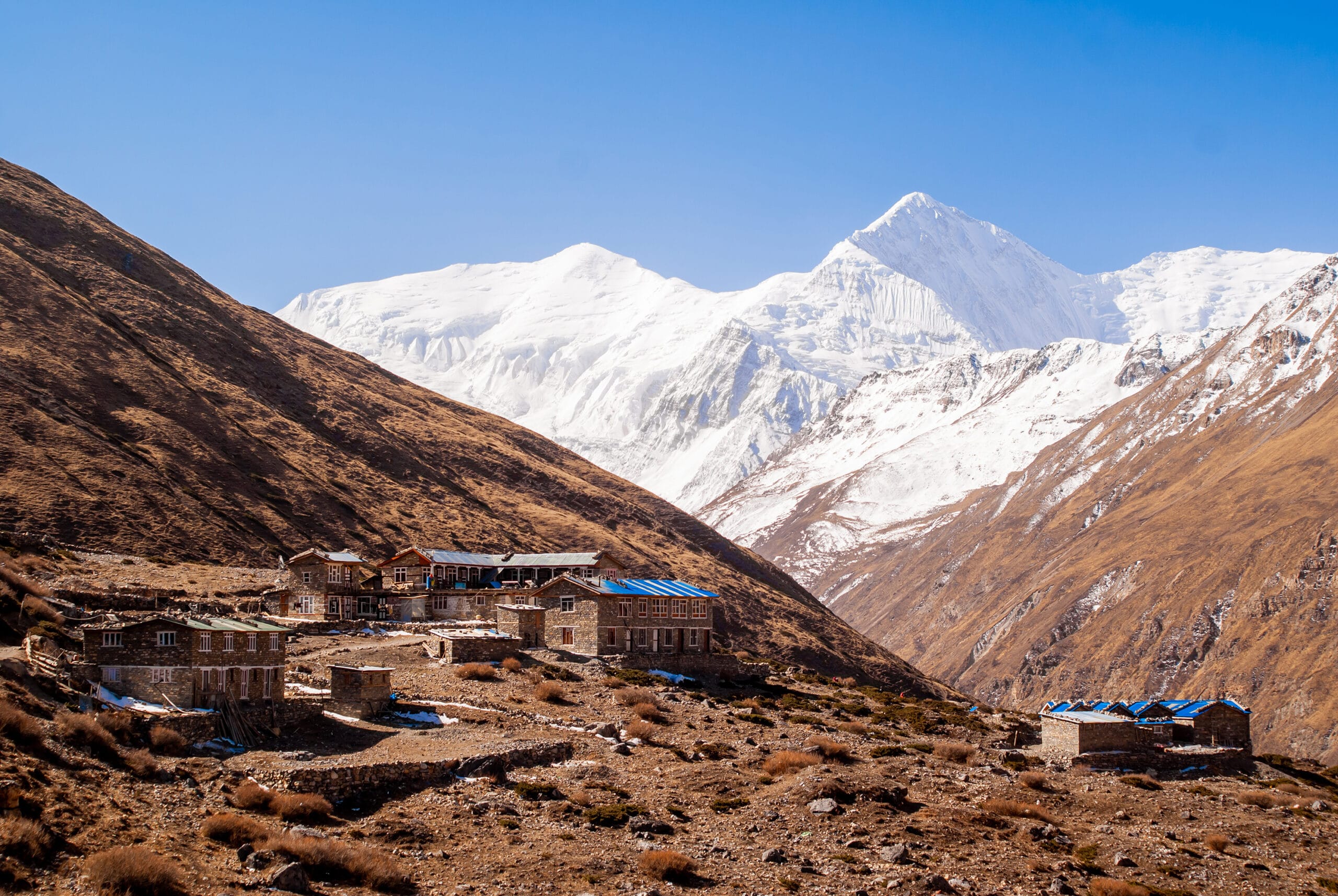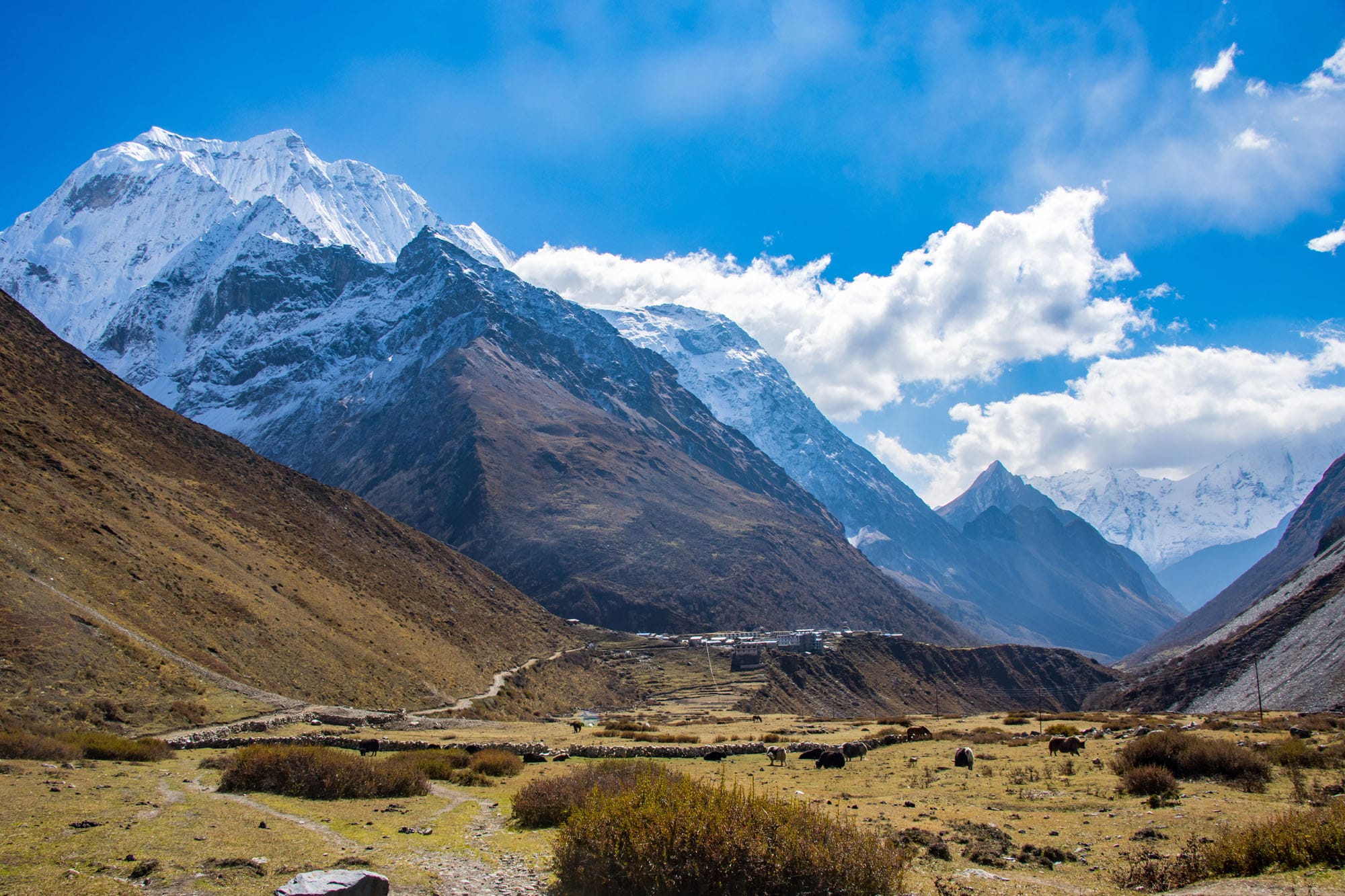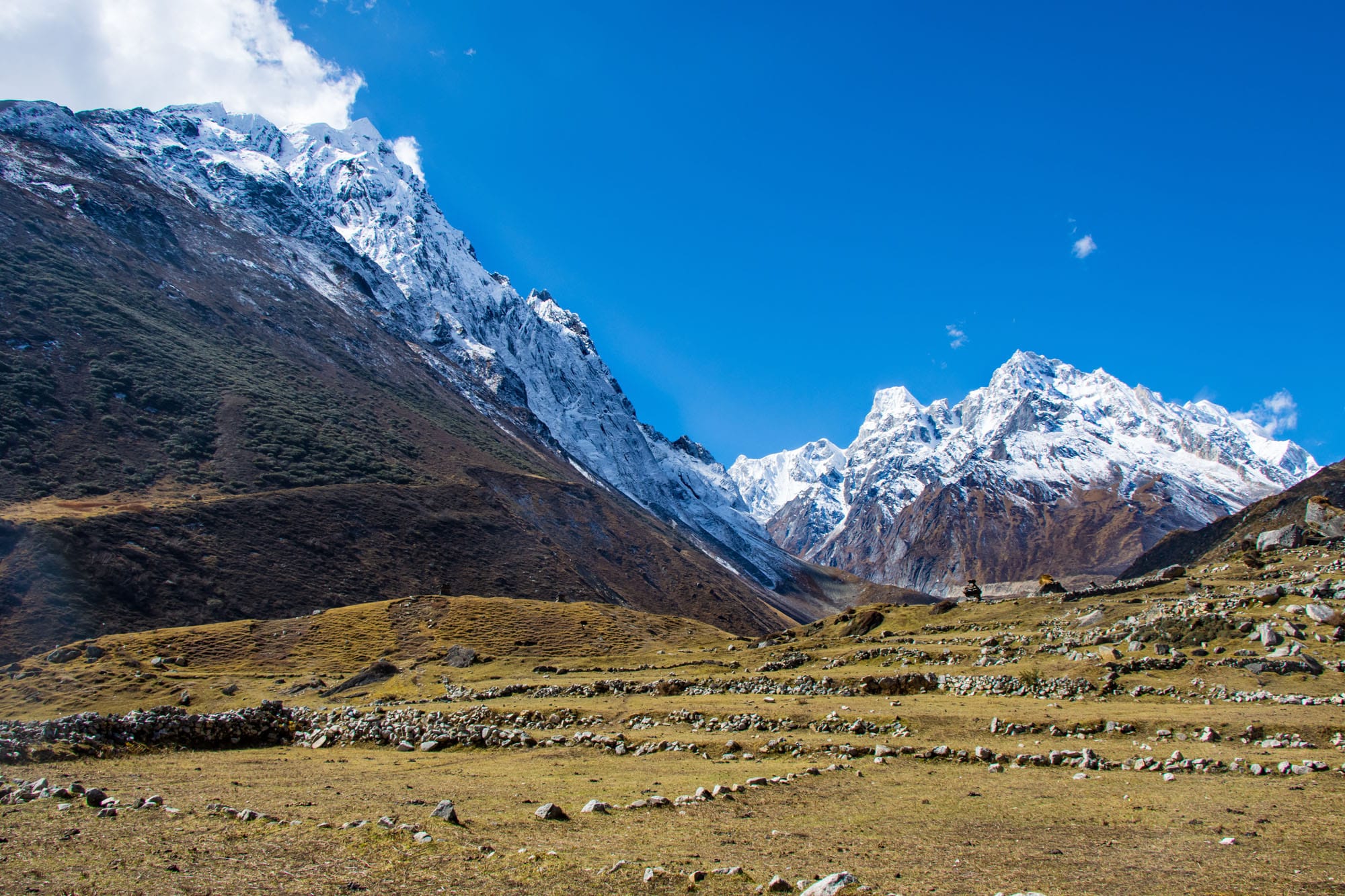Langtang Gosaikunda Trek – 13 Days
Best Season
Highest Altitude
Trip Overview
The Langtang Gosaikunda Trek is a mesmerizing journey that blends stunning natural beauty with rich cultural experiences. Spanning 13 days, this journey offers a unique adventure through the Langtang Valley, a region celebrated for its diverse landscapes, and the sacred Gosaikunda Lake, revered in Hindu mythology.
Immersion in Nepal’s Wilderness
This adventure is perfect for those seeking to immerse themselves in the serene wilderness of Nepal. Explore ancient Tamang villages and breathtaking mountain vistas.
Trek Route and Scenery
The journey begins with a drive from Kathmandu to Syabrubesi, the starting point of the trek. As you ascend through dense forests, terraced fields, and alpine meadows, you’ll encounter stunning views of snow-capped peaks, including Langtang Lirung.
Langtang National Park and Gosaikunda Lake
The trail also takes you through the Langtang National Park, home to a variety of wildlife, including red pandas and Himalayan black bears. Langtang Gosaikunda Trek adventure culminates at the sacred Gosaikunda Lake, where pilgrims from across Nepal visit during the Janai Purnima festival.
Trip Highlights:
- Scenic drive from Kathmandu to Syabrubesi.
- Exploration of the Langtang Valley and Tamang culture.
- Stunning views of Langtang Lirung and other Himalayan peaks.
- Visit to the sacred Gosaikunda Lake.
- Walk through Langtang National Park with potential wildlife sightings.
- Accommodation: Stay in comfortable teahouses during the trek; standard hotels in Kathmandu.
- Meals: Full-board meals (breakfast, lunch, and dinner) during the trek; breakfast in Kathmandu.
- Luggage: Porters provided for luggage transport (up to 15 kg per person).
- Internet/WiFi, Electricity, and Water: Available at most lodges along the trekking route (additional charges may apply); complimentary WiFi in Kathmandu hotels.
Essential Items:
- Base Layers: Thermal top and bottom
- Insulation: Fleece jacket and down jacket
- Outer Layer: Waterproof jacket and pants
- Trekking Clothes: Some pairs of trekking pants, quick-dry shirts
- Footwear: Trekking boots, camp shoes/sandals
- Headwear: Sun hat, warm hat, neck gaiter
- Hand-wear: Lightweight gloves, insulated gloves
Accessories: Sunglasses, sunscreen, lip balm , headlamp with extra batteries , trekking poles ,50-60L backpack + daypack
Personal Items: Hygiene essentials (toothbrush, toothpaste, wet wipes), Quick-dry towel ,Water bottle or hydration system (2L capacity) ,Snacks (energy bars, nuts)
Medical Kit: Personal medications, basic first aid, altitude sickness pills
Documents: Passport, trekking permits, travel insurance
Optional: Camera, power bank, Lightweight sleeping bag
Itinerary
- Drive Duration: 30-45 minutes
- Meal: Breakfast
- Highest Altitude: Kathmandu (1,400m/ 4,600ft)
Upon arrival at Tribhuvan International Airport, you will be greeted by a representative and transferred to your hotel in Kathmandu. The capital city of Nepal is a vibrant mix of ancient heritage, bustling streets, and modern influences. After checking into your hotel, you can explore the lively Thamel area, known for its trekking shops, restaurants, and cultural attractions. You may also wish to visit nearby UNESCO World Heritage Sites such as Kathmandu Durbar Square or Swayambhunath (Monkey Temple).
In the evening, a pre-trek briefing will be conducted by your tour leader, where you will receive information about the journey ahead. You can finalize any gear preparations and ensure you have everything required for the trek.
- Drive Distance: 122 km (76 miles)
- Drive Duration: 7-8 hours
- Meal: Breakfast,Lunch & Dinner
- Highest Altitude: Syabrubesi (1,550m/4932ft)
The journey begins with an early morning drive from Kathmandu to Syabrubesi, a beautiful village that serves as the gateway to the Langtang region. The scenic drive takes about 7 to 8 hours, following the winding roads along the Trishuli River, offering spectacular views of lush hills, terraced fields, and distant Himalayan peaks. The road passes through charming villages like Bidur, Trishuli Bazaar, and Dhunche, where you can observe rural Nepalese life and traditional farming practices. The final stretch of the drive is a bit rugged, with some off-road sections, adding to the sense of adventure.
Upon arrival in Syabrubesi, you will check into a teahouse and take the rest of the evening to explore the town. The village is home to the Tamang ethnic community, known for their unique culture and warm hospitality. You can take a short walk to Syabrubesi’s riverside, where the cool breeze and the sound of the flowing river create a peaceful atmosphere. As night falls, you will enjoy a delicious Nepali meal, preparing for the trekking adventure ahead.
- Trek Distance: 11 km (6.8 miles)
- Trek Duration: 7-8 hours
- Meal: Breakfast, Lunch & Dinner
- Highest Altitude: Lama Hotel (2,470m /8,104ft)
Your trek officially begins today as you leave Syabrubesi and start ascending towards Lama Hotel. The trail follows the Langtang Khola (river), crossing several suspension bridges and passing through dense forests of rhododendron, oak, and bamboo. This region is part of the Langtang National Park, home to diverse wildlife such as red pandas, Himalayan black bears, and langurs. As you make your way through the forest, you will come across small settlements like Domen and Bamboo, where you can take short breaks and enjoy tea at local teahouses.
The trail gradually becomes steeper as you approach Lama Hotel, a small trekking village surrounded by tall trees and lush greenery. The final section of the trek involves a steady climb, but the sound of the river and the cool mountain breeze make the journey refreshing. Upon reaching Lama Hotel, you will check into a teahouse, where you can relax, enjoy a warm meal, and chat with fellow trekkers about the day's experiences.
- Trek Distance: 14 km (8.7 miles)
- Trek Duration: 6-7 hours
- Meal: Breakfast, Lunch & Dinner
- Highest Altitude: Langtang Village (3,430m /11,253ft)
The trail continues along the Langtang River, gradually ascending through thick pine and rhododendron forests. The higher you go, the more panoramic views of snow-capped peaks begin to emerge. After a couple of hours of trekking, you will pass Ghora Tabela (Horse Stable), a small settlement with a few lodges and an army checkpoint. From here, the valley begins to open up, revealing breathtaking views of Langtang Lirung (7,227m) and other surrounding peaks.
As you proceed, you will notice traditional stone houses, Buddhist prayer wheels, and small chortens (stupas), indicating the rich cultural heritage of the Tamang people. The trail takes you through villages that were heavily affected by the 2015 earthquake, and you can see the resilience of the local community in their efforts to rebuild. After about 6 to 7 hours of trekking, you will reach Langtang Village, where you will stay for the night. This is an excellent place to explore and interact with the locals, learning about their traditions and daily life in the mountains.
- Trek Distance: 7 km (4.3 miles)
- Trek Duration: 3-4 hours
- Meal: Breakfast, Lunch & Dinner
- Highest Altitude: Kyanjin Gompa (3,870m /12,697ft)
Today’s trek is relatively shorter but incredibly scenic, as you make your way toward Kyanjin Gompa, the last permanent settlement in the Langtang Valley. The trail gradually ascends through yak pastures, glacial streams, and small wooden bridges, offering breathtaking views of Langtang Lirung, Dorje Lakpa, and Gangchempo. Along the way, you will pass Mundu and Sindum, two small settlements where you can take a short break.
Upon arriving at Kyanjin Gompa, you will check into a teahouse and have the rest of the day to explore. The village is famous for its ancient Buddhist monastery, which you can visit to observe the monks performing their daily rituals. You can also visit the Kyanjin Cheese Factory, where traditional yak cheese is produced. The village is surrounded by stunning mountain scenery, making it a perfect place to relax and soak in the natural beauty.
- Meal: Breakfast, Lunch & Dinner
- Highest Altitude: Kyanjin Gompa (3,870m /12,697ft) & Tserko Ri (5,000m/16,404ft)
To adjust to the altitude, today is a rest and acclimatization day, with optional hikes to nearby viewpoints. The most popular hike is to Tserko Ri (5,000m), a challenging but rewarding trek that offers panoramic views of Langtang Lirung, Shishapangma, and the Langtang Glacier. The hike takes about 6 hours round-trip, and though steep, it is well worth the effort for the breathtaking scenery.
Alternatively, you can take a shorter trek to the Langtang Glacier viewpoint or simply explore the village, interacting with the locals and visiting the monastery. This day is essential for acclimatization, ensuring that your body adjusts to the high altitude before continuing the trek.
- Trek Distance: 21 km (13 miles)
- Trek Duration: 7-8 hours
- Meal: Breakfast, Lunch & Dinner
- Altitude: Lama Hotel (2,470m /8,104ft)
After an early breakfast, you will begin your descent back to Lama Hotel, retracing your steps through Langtang Village and Ghora Tabela. The trek is easier as you lose altitude, allowing you to enjoy the views more comfortably. Along the way, you will pass Buddhist mani walls, chortens, and traditional Tamang villages, reflecting on the incredible journey so far.
The forests are livelier on the way down, and you may encounter more wildlife. After about 7 to 8 hours of trekking, you will reach Lama Hotel, where you can relax, enjoy a warm meal, and share stories with fellow trekkers.
- Trek Distance: 11 km (6.8 miles)
- Trek Duration: 6-7 hours
- Meal: Breakfast, Lunch & Dinner
- Altitude: Thulo Syabru (2,210m /7,251ft)
Today, the trail takes a different route as you head towards Thulo Syabru, a beautiful Tamang village known for its unique culture. The path winds through dense forests, rivers, and small settlements, gradually descending before climbing again toward the village. Thulo Syabru offers magnificent views of Ganesh Himal and Langtang Himal, making it a picturesque stopover.
Upon arrival, you can explore the village, interact with the friendly locals, and visit a Tamang Buddhist monastery. The village has a peaceful atmosphere, making it a great place to rest before continuing to higher altitudes.
- Trek Distance: 7 km (4.3 miles)
- Trek Duration: 5-6 hours
- Meal: Breakfast, Lunch & Dinner
- Highest Altitude: Sing Gompa (3,250m /10,662ft)
Leaving Thulo Syabru, the trail gradually ascends through dense forests of rhododendron, oak, and pine. As you climb higher, the landscape starts to change, with fewer trees and more open ridges offering spectacular views of the surrounding mountains. The path is peaceful, and you may spot musk deer, langurs, and various species of Himalayan birds along the way. After a few hours, you will reach Dursagang, a small settlement where you can take a short break before continuing uphill.
As you trek higher, you will notice prayer flags and chortens, indicating the deep Buddhist influence in the region. The final stretch takes you to Sing Gompa (Chandanbari), a serene village known for its ancient monastery and cheese factory. Upon arrival, you can visit the monastery, where the peaceful surroundings and the sight of monks chanting prayers create a calming atmosphere. The village also has a yak cheese factory, where you can sample locally made cheese, a unique delicacy of the Langtang region. In the evening, you can enjoy the mesmerizing sunset over the Ganesh Himal range before resting for the night.
- Trek Distance: 6 km (3.7 miles)
- Trek Duration: 5-6 hours
- Meal: Breakfast, Lunch & Dinner
- Highest Altitude: Gosaikunda Lake (4,380m /14,370ft)
Today’s trek is one of the most challenging yet rewarding sections of the journey, as you make your way to the sacred Gosaikunda Lake. The trail begins with a steep ascent through alpine meadows and rugged terrain, offering breathtaking views of the Langtang and Ganesh Himal ranges. As you ascend, you will pass Cholangpati (3,654m) and Lauribina (3,910m), where you can take short breaks and enjoy the panoramic mountain vistas.
Beyond Lauribina, the landscape becomes barren and more dramatic, with rocky terrain and glacial moraines. After a final steep climb, you will reach Gosaikunda, a sacred alpine lake revered by both Hindus and Buddhists. According to legend, Lord Shiva created the lake by piercing a glacier with his trident, and many pilgrims visit this site during the Janai Purnima festival. The shimmering blue waters of Gosaikunda, surrounded by snow-capped peaks, create a truly magical setting. You will spend the night near the lake, soaking in its spiritual and natural beauty.
- Trek Distance: 18 km (11.1 miles)
- Trek Duration: 7-8 hours
- Meal: Breakfast, Lunch & Dinner
- Altitude: Dhunche (1,965m /6,447ft)
After an early morning sunrise view over Gosaikunda, you will begin your descent toward Dhunche, the headquarters of the Rasuwa District. The trail follows a steep downhill path through rocky terrain, gradually leading back into forests of rhododendron and pine. The descent is long but offers spectacular views of the Himalayan ranges and the lush valleys below.
As you descend, you will pass through small Tamang villages, where you can observe the daily lives of the local people. The trail eventually connects to a wider dirt road, leading to Dhunche, a bustling town with lodges, shops, and government offices. Here, you can enjoy a well-deserved rest, explore the town, and reflect on the incredible journey through the Langtang and Gosaikunda regions.
- Drive Distance: 99.9 km (62 miles)
- Drive Duration: 5-6 hours
- Meal: Breakfast,Lunch & Dinner
- Altitude: Kathmandu (1,400m/ 4,600ft)
After breakfast, you will board a jeep or bus for the scenic drive back to Kathmandu. The winding mountain roads take you through forested hills, river valleys, and terraced farmlands, offering a final glimpse of Nepal’s stunning landscapes. Along the way, you may stop for short breaks at roadside tea houses, where you can enjoy some local snacks and interact with fellow travelers.
As you approach Kathmandu, the bustling city atmosphere begins to replace the tranquility of the mountains. Upon arrival, you will be transferred to your hotel, where you can take a well-earned rest, enjoy a warm shower, and indulge in some delicious Nepali cuisine. In the evening, a farewell dinner with traditional Nepali cuisine is a great way to celebrate the successful completion of your trek which is hosted by mount elegance team. This marks the end of your adventurous trek, leaving you with unforgettable memories of the Himalayas.
- Drive Duration: 30-45 minutes
- Meal: Breakfast
- Altitude: Kathmandu(1,400m/ 4,600ft)
On your final day in Nepal, you will have some free time to explore the city, depending on your departure schedule. You can visit UNESCO World Heritage Sites like Swayambhunath (Monkey Temple), Pashupatinath Temple, or Kathmandu Durbar Square, or simply relax at a rooftop café, soaking in the views of the Kathmandu Valley.
As your flight time approaches, you will be transferred to Tribhuvan International Airport, where you will bid farewell to Nepal. With incredible memories of the Langtang and Gosaikunda trek, you will leave with a deep appreciation for the Himalayan landscapes, rich Tamang culture, and warm hospitality of the Nepalese people.
Book Now
Send an Inquiry
Got A Question?

Mr. Shishir Dhakal
Price Inclusion
- Airport transfer in Kathmandu.
- Transportation from Kathmandu to Syabrubesi and back..
- Accommodation in Kathmandu (3 star hotel) with breakfast.
- Accommodation in tea houses during the trek.
- Three meals a day during the trek.
- An experienced trekking guide.
- National Park entry permits.
- Duffel bag and sleeping bag for trekking (Should be returned after trek completion).
- One porter for two trekkers.
- Seasonal fresh fruit as dessert every evening after dinner.
- Mount Elegance free Tshirt and Route map.
- Complimentary first aid box (Guide will carry during trekking).
- Oximeter to measure the Oxygen (For awareness of the high altitude sickness).
- Farewell dinner at the end of the trek.
- Certificate after trek completion.
Price Exclusion
- International flights.
- Nepal entry visa fee
- Personal trekking equipment.
- Travel insurance.
- Tips for guides and porters.
- Any expenses not mentioned in the inclusions.
Additional Information
Trip Map
Meals and Accommodation on Langtang Gosaikunda Trek
The Langtang Gosaikunda Trek is a journey that combines the beauty of Langtang Valley with the sacred Gosaikunda Lake, providing trekkers with an immersive experience of Nepali hospitality, mountain views, and cultural exploration. Accommodations are tea houses along the trail, with city comforts in Kathmandu before and after the trek.
In Kathmandu, accommodations are arranged in well-maintained tourist-standard hotels. These hotels offer comfortable, air-conditioned rooms with ensuite bathrooms, cozy beds, complimentary breakfasts, and Wi-Fi. The modern amenities make them a restful place to stay before and after the trek, with fine dining options available.
On the Langtang Gosaikunda Trek, tea houses serve as the primary accommodation. These tea houses provide basic twin-sharing rooms with beds, blankets, and pillows. Although simple, they are generally clean and offer comfort after a day of trekking. Shared bathrooms and charging facilities are often available, with hot showers provided for a small fee. As the altitude increases, accommodations tend to become more basic, though still warm and welcoming.
Meals on the trek are freshly prepared and tailored to suit the nutritional needs of trekkers. Breakfast options include porridge, Tibetan bread, eggs (boiled, fried, or scrambled), pancakes, and hot drinks like tea, coffee, and hot chocolate. Lunch and dinner typically feature hearty, local dishes like Dal Bhat (rice, lentils, vegetables, and pickles), noodles, fried rice, pasta, momos (dumplings), and various soups. Snacks, including biscuits, chocolate bars, and fresh fruits, are also available. Locally sourced ingredients give these meals an authentic flavor, supporting the local communities along the trail.
With a well-balanced mix of scenic trekking, nourishing meals, and comfortable tea house accommodations, the Langtang Gosaikunda Trek provides an unforgettable experience in the Himalayas, combining both natural beauty and local culture.
Best Season for Langtang Gosaikunda Trek
The best seasons for the Langtang Gosaikunda Trek are spring (March to May) and autumn (September to November), as these months offer ideal trekking conditions, clear skies, and stunning mountain and lake views.
Spring (March to May)
- Weather: Days are mild to warm, and nights are cool, making it a pleasant season for trekking. Clear skies enhance the views.
- Temperature:
- Lower regions (1,000m to 2,500m): 15°C to 25°C during the day, 5°C to 10°C at night.
- Higher regions (up to 4,380m, Gosaikunda Lake): 5°C to 15°C during the day, -5°C to 5°C at night.
- Highlights: The rhododendron forests are in bloom, adding vibrant colors to the trail. Views of Langtang Lirung, Ganesh Himal, and Manaslu are particularly impressive, and Gosaikunda Lake is clear and stunning.
Autumn (September to November)
- Weather: Clear skies, mild temperatures, and dry air make autumn the best season for trekking.
- Temperature:
- Lower regions (1,000m to 2,500m): 15°C to 25°C during the day, 5°C to 10°C at night.
- Higher regions (up to 4,380m, Gosaikunda Lake): 5°C to 15°C during the day, -5°C to 5°C at night.
- Highlights: After the monsoon, the landscapes are lush and vibrant, and the visibility is ideal for mountain views. The clear, pristine waters of Gosaikunda Lake create a serene environment. Local festivals like Dashain and Tihar add a festive feel to the villages.
Winter (December to February)
- Weather: Cold temperatures and occasional snowfall, especially at higher altitudes. While skies are generally clear, trekkers should be prepared for cold conditions.
- Temperature:
- Lower regions (1,000m to 2,500m): 10°C to 15°C during the day, 0°C to 5°C at night.
- Higher regions (up to 4,380m, Gosaikunda Lake): -5°C to 5°C during the day, -10°C to -5°C at night.
- Challenges: Snow can make trails to Gosaikunda Lake challenging and even impassable. Winter trekking here is best for experienced trekkers with proper winter gear.
Monsoon/Summer (June to August)
- Weather: Frequent rain, humid conditions, and cloudy skies make trekking more difficult during the monsoon.
- Temperature:
- Lower regions (1,000m to 2,500m): 20°C to 30°C during the day, 10°C to 20°C at night.
- Higher regions (up to 4,380m, Gosaikunda Lake): 15°C to 20°C during the day, 5°C to 10°C at night.
- Challenges: Heavy rainfall, leeches, and slippery trails can make trekking unpleasant. However, the landscape becomes lush, and fewer trekkers mean quieter trails.
Equipment Checklist
Trekking in Nepal is an incredible adventure, taking you through diverse landscapes, from lush forests to rugged mountain trails. To fully enjoy the experience, it’s crucial to pack the right equipment. Here’s an essential checklist to help you prepare for your trek, ensuring you’re ready for the challenges and beauty of the Himalayas.
1. Clothing
- Base Layers: Moisture-wicking base layers (thermal tops and bottoms) are essential for regulating your body temperature. Opt for lightweight, breathable materials.
- Mid Layers: Fleece jackets or lightweight down jackets provide warmth in colder temperatures. These layers should be easy to add or remove as needed.
- Outer Layers: A waterproof and windproof jacket is essential to protect against rain, wind, and snow. Make sure it’s breathable to stay comfortable during strenuous activities.
- Trekking Pants: Lightweight, quick-drying pants are ideal. Consider packing thermal pants for colder regions or seasons.
- Gloves, Hats, and Buffs: Warm gloves, a woolen hat, and a buff or neck gaiter help protect against the cold at high altitudes.
- Trekking Socks: High-quality, moisture-wicking socks (at least three pairs) are crucial to prevent blisters and keep your feet dry.
2. Footwear
- Trekking Boots: Sturdy, well-fitted, and waterproof trekking boots with good ankle support are essential. Break them in before your trek to avoid blisters.
- Sandals or Camp Shoes: Lightweight sandals or camp shoes for relaxing at tea houses or lodges after a long day of trekking.
3. Backpack and Storage
- Daypack (20-30 liters): A small, comfortable daypack with rain cover to carry essentials like water, snacks, camera, and extra layers.
- Duffel Bag (60-80 liters): For your main gear, use a durable, waterproof duffel bag that will be carried by porters.
- Dry Bags or Ziplock Bags: For protecting electronics, documents, and clothes from moisture.
4. Trekking Gear
- Trekking Poles: Adjustable trekking poles reduce the strain on your knees, especially during steep descents.
- Headlamp with Extra Batteries: Essential for early morning starts, late finishes, or use in lodges where electricity may be limited.
- Water Bottles and Purification: Carry reusable water bottles and purification tablets or a water filter to ensure safe drinking water.
- Sleeping Bag: A four-season sleeping bag rated for temperatures as low as -10°C to -15°C is recommended for high-altitude treks.
5. Health and First Aid
- Personal First Aid Kit: Include essentials like band-aids, antiseptic wipes, blister treatment, pain relievers, and any personal medications.
- Sunscreen and Lip Balm: High SPF sunscreen and lip balm are essential to protect against strong UV rays at high altitudes.
- Hand Sanitizer and Wet Wipes: Useful for maintaining hygiene when water is limited.
- Altitude Sickness Medication: Consult your doctor about medications like Diamox for preventing altitude sickness.
6. Personal Items and Extras
- Snacks and Energy Bars: Pack lightweight, high-energy snacks for a quick boost on the trail.
- Sunglasses with UV Protection: Essential for protecting your eyes from the intense sunlight and snow glare at high altitudes.
- Camera or Smartphone: To capture the breathtaking scenery. Don’t forget extra batteries or a portable charger.
- Personal Toiletries: Include biodegradable soap, toothbrush, toothpaste, and a small towel.
- Cash: Carry enough local currency for expenses along the trail, as ATMs are not available in remote areas.
7. Documents
- Passport and Visa: Carry your passport, visa, and photocopies in a waterproof pouch.
- Permits: Obtain trekking permits such as the TIMS card and national park or conservation area permits, depending on your route.
- Travel Insurance Details: Ensure you have comprehensive travel insurance covering high-altitude trekking, emergency evacuations, and medical expenses.
Final Tips
- Pack Light: Try to keep your backpack under 10-15 kg. The lighter your pack, the more enjoyable your trek will be.
- Layer Up: Layering is key for comfort in Nepal’s changing weather conditions. Bring versatile clothing that can be easily added or removed.
- Double-Check Your Gear: Before you set off, double-check that you have all the essentials. Missing a crucial item could make your trek less comfortable or even dangerous.
Frequently Asked Questions(FAQs)
Can I use my mobile phone in Nepal?
Yes, you can use your mobile phone in Nepal, but you may need to take a few precautions. Nepal has two primary mobile networks: Nepal Telecom (NTC) and Ncell. Both networks offer good coverage in urban areas, while coverage can be limited in rural areas. If you have an international roaming plan, you can use your phone to make calls, send texts, and access the internet. However, international roaming rates can be high, so it’s a good idea to check with your provider before your trip. Alternatively, you can purchase a local SIM card or rent a portable Wi-Fi hotspot from a local provider, which can be a cost-effective and convenient option. At Mount Elegance Treks and Expedition, we can provide guidance on the best options for staying connected during your time in Nepal.
What payment methods does Mount Elegance Treks accept?
Here is a potential answer for the FAQ question:
What payment methods does Mount Elegance Treks accept?
At Mount Elegance Treks, we offer a range of payment options to make booking your trek as convenient as possible. We accept bank transfers, credit card payments (including Visa, Mastercard, and American Express), and online payments through our website. We also accept payment through PayPal. For bookings, a deposit of 20% is required to secure your spot, with the balance due 30 days prior to your trek departure date. Our payment process is secure and transparent, and we’ll provide you with a detailed invoice and payment instructions once you’ve booked your trek. If you have any questions or concerns about payment, feel free to contact us!
Does Mount Elegance Treks arrange permits for trekking?
Here is a potential answer for the FAQ question:
Does Mount Elegance Treks arrange permits for trekking?
Yes, we take care of all the necessary permits and paperwork for our treks. As a licensed and reputable trekking operator, we have established relationships with the relevant authorities to ensure that all necessary permits are obtained in a timely and efficient manner. This includes trekking permits, national park fees, and any other required documents. Our team will arrange and obtain all the necessary permits on your behalf, so you can focus on preparing for your adventure. We’ll take care of the details, so you can enjoy a hassle-free trekking experience with Mount Elegance Treks!
Are Mount Elegance Treks guides certified in first aid?
Here is a potential answer for the FAQ question:
Are Mount Elegance Treks guides certified in first aid?
Yes, our guides are highly trained and certified in wilderness first aid. We take the safety and well-being of our clients very seriously, and our guides undergo regular training to ensure they are equipped to respond to any medical emergency that may arise during the trek. Our guides are certified in basic life support, wound management, and altitude sickness prevention, among other topics. Additionally, we carry a comprehensive first aid kit with us on every trek, and our guides are trained to use it effectively. You can feel confident and secure knowing that you’re in good hands with Mount Elegance Treks!
What equipment does Mount Elegance Treks provide?
Here is a potential answer for the FAQ question:
What equipment does Mount Elegance Treks provide?
At Mount Elegance Treks, we strive to ensure that you have everything you need to enjoy your trek to the fullest. Our package includes the use of necessary trekking equipment such as trekking poles, sleeping bags, down jackets, and first aid kits. We also provide durable and high-quality backpacks and duffel bags to carry your personal gear. Our guides are also equipped with communication devices, maps, and emergency shelter in case of unexpected weather conditions. However, we recommend that you bring your own personal clothing, shoes, and any specific gear that you prefer to use. If you have any questions or concerns about what to bring, feel free to contact us!
How do I book a trek with Mount Elegance Treks?
Booking a trek with us is easy and straightforward. To confirm your trip, simply follow these steps: 1) Choose your desired trek itinerary from our website or contact us to customize a trip, 2) Provide us with your travel dates, passenger details, and preferred payment method, 3) Receive a detailed itinerary and quote from our team, 4) Make a deposit to secure your booking, and 5) Finalize payment and complete any necessary paperwork. You can book online, email us at [email address], or call us at [phone number] to speak with a friendly booking consultant. We look forward to helping you plan an unforgettable adventure in Nepal!
Can Mount Elegance Treks arrange custom itineraries?
Here is a potential answer for the FAQ question:
Can Mount Elegance Treks arrange custom itineraries?
Absolutely! At Mount Elegance Treks, we understand that every traveler is unique, with their own interests and preferences. That’s why we offer custom itinerary planning services to tailor your Nepal travel experience to your specific needs and desires. Whether you’re looking to add or remove activities, extend your stay, or explore off-the-beaten-path destinations, our expert team is happy to work with you to create a personalized trip that exceeds your expectations. Simply contact us to share your ideas and let us take care of the rest!
How much does the Langtang trek cost?
The cost of the Langtang trek can vary depending on several factors, including the type of accommodation, mode of transportation, and services required. At Mount Elegance Treks and Expedition, we offer a range of packages to suit different budgets and preferences.
On average, the cost of the Langtang trek can range from $800 to $1,200 per person, depending on the services included. Here’s a breakdown of the estimated costs:
* **Budget-friendly option**: $800
- $1,000 per person, which includes basic accommodation, meals, and transportation.
* **Standard option**: $1,000 – $1,200 per person, which includes mid-range accommodation, meals, and transportation, as well as guide services and trekking permits.
* **Luxury option**: $1,200 – $1,500 per person, which includes high-end accommodation, meals, and transportation, as well as personal guide services and special perks.The costs include:
* **Accommodation**: Tea houses, lodges, and guesthouses
* **Meals**: Breakfast, lunch, and dinner
* **Transportation**: Private vehicle transfer from Kathmandu to Syabrubesi and back
* **Guide services**: Experienced guide and porter
* **Trekking permits**: Langtang National Park Permit and TIMS Card
* **Miscellaneous**: Insurance, emergency fund, and contingency planningAt Mount Elegance Treks and Expedition, we offer a transparent and all-inclusive pricing system, so you can focus on planning your trip without worrying about hidden costs. Our experienced team will help you customize a package that fits your needs and budget, ensuring a memorable and enjoyable Langtang trek experience.
What is the best time to do the Langtang trek?
The best time to do the Langtang trek is from September to November and from March to May, when the weather is generally clear and stable. These periods offer the most ideal conditions for trekking, with mild temperatures, fewer crowds, and stunning mountain views.
* **Autumn (September to November)**: The air is crisp and clear, with wildflowers in bloom, adding vibrant colors to the trek. The weather is usually sunny, with moderate temperatures ranging from 10°C to 20°C (50°F to 68°F).
* **Spring (March to May)**: The weather is mild and pleasant, with temperatures ranging from 10°C to 20°C (50°F to 68°F). The rhododendron forests are in full bloom, creating a breathtaking spectacle of colors.
Trekking during these periods also offers the best views of the surrounding mountains, including the Langtang Lirung and Ganesh Himal ranges. The monsoon season (June to August) can make the trails slippery and difficult to navigate, while the winter season (December to February) can be very cold, with temperatures often dropping below freezing.
At Mount Elegance Treks and Expedition, we recommend planning your Langtang trek during the autumn or spring seasons to ensure the best weather conditions and an unforgettable trekking experience. Our experienced guides will help you plan and prepare for your trek, ensuring a safe and enjoyable journey in the beautiful Langtang region.
What permits are needed for the Langtang trek?
To trek in the Langtang region, several permits and documents are required to ensure a safe and regulated experience. At Mount Elegance Treks and Expedition, we take care of all the necessary permits and paperwork for you. The main permits needed for the Langtang trek include:
* **Langtang National Park Permit**: This permit is required for all trekkers entering the Langtang National Park.
* **TIMS (Trekkers’ Information Management System) Card**: This card is issued by the Nepal Government and is required for all trekkers in Nepal.
* **Guide License**: Our experienced guides hold a valid guide license, which is required for all guided treks in Nepal.
In addition, we also need to obtain a permit from the Langtang Village Municipality for the trek. Our team will handle all the necessary permits and paperwork, ensuring a smooth and hassle-free experience. With Mount Elegance Treks and Expedition, you can be sure that all necessary permits are in place, and you’re ready for an unforgettable adventure in the Langtang region.
Please note that we will also provide you with a trekking certificate, which is required for your exit from Nepal. Our team will take care of all the logistics, so you can focus on enjoying your trek and taking in the breathtaking scenery of the Langtang region.
What is the Langtang Valley trek difficulty level?
The Langtang Valley trek is considered a moderately challenging trek, suitable for trekkers with a good level of physical fitness. The trek involves walking for 5-6 hours a day, with an elevation gain of up to 3,000 meters, and navigating through rugged terrain, including stone steps, suspension bridges, and uneven trails.
The difficulty level can be broken down into several aspects:
* **Physical demands**: The trek requires a good level of physical fitness, with daily walks on uneven terrain.
* **Altitude**: The trek involves reaching an altitude of 3,500 meters at Kyanjin Gompa, which can cause some altitude sickness in trekkers.
* **Terrain**: The trek involves navigating through rugged terrain, including steep ups and downs, and uneven trails.
However, the rewards of the Langtang Valley trek are well worth the challenges, with breathtaking mountain views, including the Langtang Lirung and Ganesh Himal ranges, and stunning landscapes. The trek is also relatively less crowded compared to other popular treks in Nepal, making it a great option for those seeking a more secluded and peaceful experience.
At Mount Elegance Treks and Expedition, we recommend that trekkers have some prior hiking experience and be in good physical shape to complete the trek. Our experienced guides will monitor your progress and provide support to ensure a safe and successful trek.
Does Mount Elegance Treks require a deposit for booking?
Here is a potential answer for the FAQ question:
Does Mount Elegance Treks require a deposit for booking?
Yes, to secure your spot on one of our trekking adventures, a deposit of 20% of the total tour cost is required at the time of booking. This deposit is a non-refundable portion of the total cost, but it ensures your place on the trek. The balance of the payment is due 30 days prior to your trek departure date. By paying the deposit, you’re committing to join us on this amazing adventure, and we’ll send you a confirmation invoice and all the necessary details to get you started. Don’t worry, we’ll guide you through the payment process and answer any questions you may have!
Experiences That Last a Lifetime
Verified Fantastic Annapurna Base Camp Trek Everything was perfectly organized, down to the last detail. Everything ran smoothly and was very well planned. The care and company were absolutely lovely 🙂 it was amazing time. 9 days of trekking with breathtaking views, delicious food along the way, and amazing guides.On top of that, I ended up in the hospital because of appendicitis, and I was never alone — the organizers surrounded me with exceptional care. Thank you Shishir 🙏🏻Verified Very amazing. Very beautiful places. Breathtaking views and the guide @ Mr. Santosh, very nice and amazing talent.The food and culture was purely loss of words to us. Thank you.Verified Najpiękniejsze góry świata, cudowny magiczny czas. Wspaniale doświadczenie, doskonała organizacja, przemili przewodnicy i porterzy, zawsze gotowi pomóc i wesprzeć radą. Wyprawa którą na zawsze pozostanie w moim sercu.Doznania których nie sposób doświadczyć nie biorąc udziału w tej wyprawie. Z pewnością polecę udział w tej przygodzie moim przyjaciołom.Verified Annapurna circuit, Nar Poo trek, Mardi himal, etc This company manages the entire process very responsibly and leads the contract in detail, very kindly and reliably. Finally all costs are more reasonable than other companiesVerified Mr tourism "I had an incredible experience with Mouth elegance during my Mr. Tourism journey! Their professionalism, expert guidance, and warm hospitality made every trek seamless and unforgettable. Highly recommended for anyone looking to explore Nepal’s breathtaking landscapes!"Verified Annapurna Rounding/Punhill.abc Dream-like sea trip February 13 Annapurna Rounding/Punhill.abcTrekkingMeeting with the president and guide Ray at Tammel Hotel...Knowing everything about travel Thank you for moving forward...I was able to leave the trekking. Thank you.Without completing a journey of 20 days With the hard work of well-led Ray GaidenWe had a comfortable and enjoyable trip.Thank you for the careful care of the local travel agent.I wish to visit again next time.We wish the unlimited development of the travel company.Verified The most wonderful and satisying Trek with the best team b I had the most amazing trip. I had been to Poonhill trek ! Thanks to Mr Shishir Dhakal, and Mount Elegance, such a supportive guy ! Without your help, i may not have such good trip ! my best memory of life !

